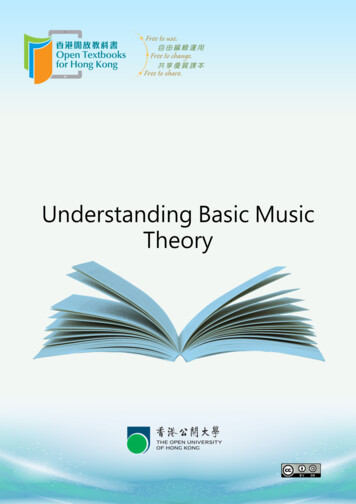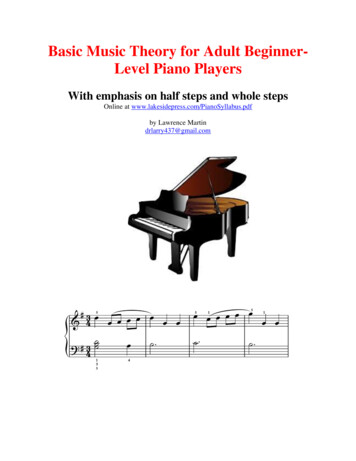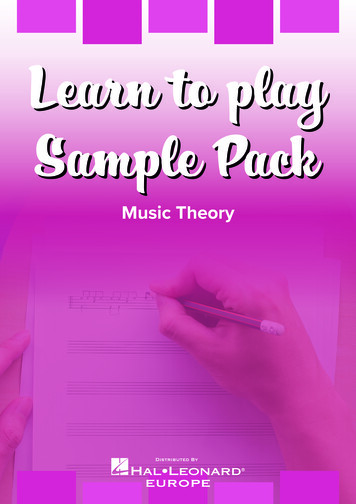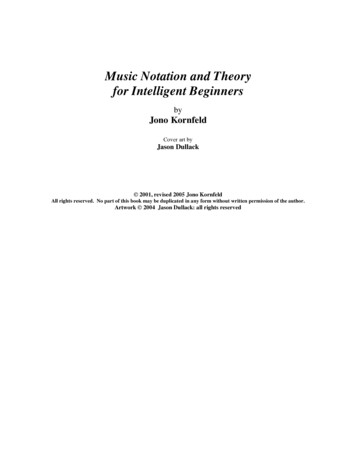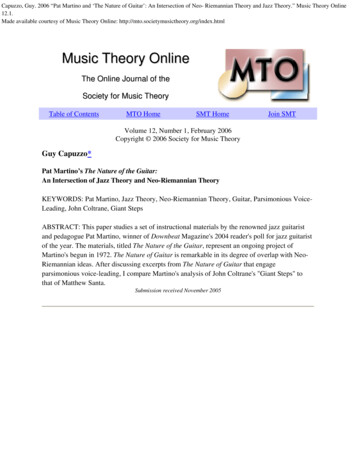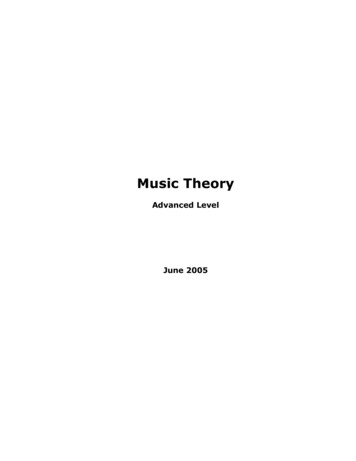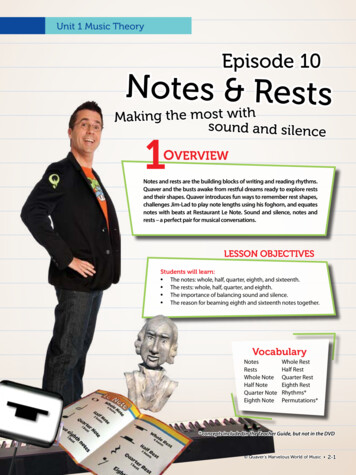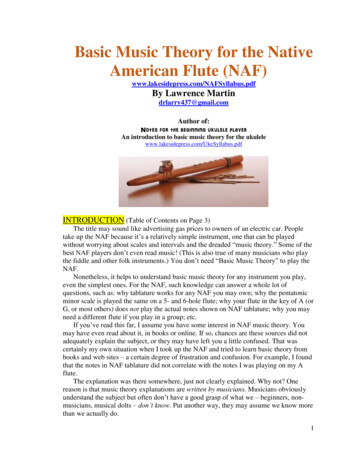
Transcription
Basic Music Theory for the NativeAmerican Flute (NAF)www.lakesidepress.com/NAFSyllabus.pdfBy Lawrence Martindrlarry437@gmail.comAuthor of:Notes for the beginning ukulele playerAn introduction to basic music theory for the UCTION (Table of Contents on Page 3)The title may sound like advertising gas prices to owners of an electric car. Peopletake up the NAF because it’s a relatively simple instrument, one that can be playedwithout worrying about scales and intervals and the dreaded “music theory.” Some of thebest NAF players don’t even read music! (This is also true of many musicians who playthe fiddle and other folk instruments.) You don’t need “Basic Music Theory” to play theNAF.Nonetheless, it helps to understand basic music theory for any instrument you play,even the simplest ones. For the NAF, such knowledge can answer a whole lot ofquestions, such as: why tablature works for any NAF you may own; why the pentatonicminor scale is played the same on a 5- and 6-hole flute; why your flute in the key of A (orG, or most others) does not play the actual notes shown on NAF tablature; why you mayneed a different flute if you play in a group; etc.If you’ve read this far, I assume you have some interest in NAF music theory. Youmay have even read about it, in books or online. If so, chances are these sources did notadequately explain the subject, or they may have left you a little confused. That wascertainly my own situation when I took up the NAF and tried to learn basic theory frombooks and web sites – a certain degree of frustration and confusion. For example, I foundthat the notes in NAF tablature did not correlate with the notes I was playing on my Aflute.The explanation was there somewhere, just not clearly explained. Why not? Onereason is that music theory explanations are written by musicians. Musicians obviouslyunderstand the subject but often don’t have a good grasp of what we – beginners, nonmusicians, musical dolts – don’t know. Put another way, they may assume we know morethan we actually do.1
Perhaps the best way to learn basic music theory is to study piano, so I began Piano101. I also took up the ukulele, and by studying both instruments gradually learned aboutmusical keys, scales and intervals. To help me better understand the uke, I wrote abeginner’s music theory book for the instrument, which has been well received on ukeforums.Then I decided to create a similar syllabus for the NAF – from the perspective of abeginner and a definite non-musician. Writing this syllabus has helped me betterunderstand the NAF, and I believe it should help most non-musicians as well. If youfollow this syllabus step by step, and do the simple exercises I recommend, you shouldachieve a much deeper understanding of the NAF than you now possess.The syllabus is not a quick read, especially if you have no musical background. Ihave simplified the material as much as feasible, while still presenting what I believe arethe essentials for understanding basic NAF music theory. It is divided into four parts,with 3 steps in each part. I recommend doing only one part at a time, and even that maybe broken up into a couple of sessions. However you choose to proceed, I advise notgoing to a new step until you feel thoroughly comfortable with the previous one.NOTE. This syllabus does not teach how to blow into the flute, or how to hold it orcover the holes, or anything about the how the flute is designed. The syllabus assumesyou: 1) have a NAF; 2) know how to hold and blow into it to sound a note; 2) have accessto the internet (smart phone, tablet or computer). If you need instruction on how to hold,blow and cover the flute holes, I highly recommend a Youtube video by master playerand flute maker Odell Borg. The URL below is Part 1 of a 6-part series by Borg on flutebasics.https://www.youtube.com/watch?v D7tCU5CQ Os&list PLD72967DD3931DBF8&index 1The other five parts follow without having to enter a new URL.If you are brand new to the NAF, you might enjoy a comprehensive video GettingStarted: The Beginner’s Guide to the Native American Style Flute athttps://www.youtube.com/watch?v dqIwczesD6k.If you have specific questions about the NAF, chances are you’ll find the answer inFlutopedia, an online encyclopedia of everything about the Native American flute(http://www.flutopedia.com). I refer frequently to this essential work in the syllabus. Thegreen-shaded finger tab diagram used throughout is courtesy of Clint Goss,www.Flutopedia.com.2
BASIC MUSIC THEORYFOR THE NAFPhoto from High Spirits Flutes, https://highspirits.com/PAGEPART 1 – FLUTE KEYS AND THE PENTATONIC SCALE . 4PART 2 – SCALES, THE KEYBOARD AND THE TREBLE CLEF . 10PART 3 – THE PENTATONIC SCALE: KEYBOARD AND TREBLE CLEF . 19PART 4 – NAF TABLATURE. 28NAF MUSIC THEORY – MULTIPLE CHOICE QUIZ . 37NAF MUSIC THEORY – MULTIPLE CHOICE QUIZ ANSWERS . 40REFERENCES AND RESOURCES . 413
PART 1 – FLUTE KEYS AND THE PENTATONICSCALESTEP 1. Play the pentatonic minor scale on your NAF.This is the primary scale all modern NAFs are designed to play. Penta means five, butyou’ll play 6 notes; the 1st (lowest) and 6th (highest) are the same note, the latter anoctave higher than the former. Later I’ll define “pentatonic” but for now just play thisstandard basic scale one note at a time, as shown below, starting from left to right. Darkcircles are closed holes. The mouth end is at the top. Thus the lowest note has all holesclosed, and the highest note has just one hole closed, the 4th from the bottom.Lowest note ---------------------------------------Highest NoteFigure from: http://www.flutopedia.com/scale PentatonicMinor.htmWatch the following videos if you’re not familiar with playing this scale.https://www.youtube.com/watch?v 1RPlVL-qaOghttps://www.youtube.com/watch?v jAfBYywQr50NOTE: If you have a 5-hole flute, keep your fingers in the same position as on a 6-holeflute. As you’ll see, the 4th hole from the bottom is always covered when playing thisscale, so it doesn’t matter if you have a 5- or 6-hole flute.*4th Hole - * Keep the 4th hole covered at all times when playing the minor pentatonic scale.4
STEP 2. Check the key of your flute.The musical “key” indicates the pitch of sounds when the notes are played. A key of Aminor will have notes of a certain pitch: higher, for example, than a key of F# minor.Each NAF has its own unique musical key; if you want to play in another key, you needanother NAF. (This is in contrast to a piano or guitar, for example, which can play inmany keys). Except for pocket flutes, the key is usually printed somewhere on the body,as a single letter, e.g., A or F#. For pocket flutes it may be printed on a tag, e.g., G. (Seefigures below of three High Spirits flutes). Although not written out on the flute or thetag, these letters stand for the key of A minor, F# minor and G minor.Back of flute showing key of A (minor)5
Back of flute showing key of F# (minor)Tag that comes with pocket flute indicating it is in key of G6
STEP 3. Play the scale again with a tuner and write down the notes you play.Suppose, for example, that you have a flute in the key of A minor. This exercise willshow you what notes you are sounding when you play the minor pentatonic scale on thatflute, as shown in the figure below.Flute Key:A MinorNotes played with fingering as shown:ACDEGAYou can use a downloaded tuner from the internet, or an actual physical tuner. Theinternet offers several free tuners, but they all seem to come with some gimmick (i.e.,installing unwanted software along with the tuner). Instead, you should either pay a fewbucks for a safe, downloadable tuner to your smart phone or tablet, or buy an inexpensivephysical tuner. The tuner app I use on my smart phone is Clear Tune ( 4.99); the way itlooks on your smart phone is shown in the figure. The website tic-tuner/id286799607?mt 8.7
If you are not familiar with electronic tuners, now is the time to become familiar. Stringplayers (guitar, ukulele, mountain dulcimer) rely on them to tune their instruments. Whilethere is nothing to tune on the NAF, “seeing” the notes you play via a turner is a valuablelearning experience. THERE IS LITTLE POINT IN CONTINUING IF YOU DO NOTTAKE ADVANTAGE OF CHECKING YOUR NAF WITH A TUNER.Many physical electronic tuners can be attached to your flute, such as the Snark tunershown below. Clipping it to the opening at the bottom of your flute should not affect theplaying. You may also be able to pick up the notes by clipping it to the festish, as shown.Snark tuner on left, showing note of E. Snark tuner clipped onto the end hole(middle) and to the flute’s fetish (right).Play your flute so that the tuner (either the downloaded app, or one connected to yourflute) picks up the sound, and see what note is registered. If clipping it to the end hole andthe fetish don’t give consistent results, then I recommend using a downloaded tuner.Whatever method you use, write down the notes for each fingering position. You mayhave to play the scale a few times until you have consistent responses. A word of caution,though. YOU CAN CHANGE THE PITCH OF A NOTE BY BLOWING HARDER ORSOFTER. Blowing harder makes the pitch go up, toward the “sharp” side of the note(e.g., from A to A#), and blowing softer makes the pitch go down, toward the flat side ofthe note (e.g., A to Ab). Try to blow “medium.” Downloaded tuners such as Clear Tuneare very precise, so don’t be surprised by needle fluctuation. Still, you should end upwith notes that accurately reflect the key of your flute. Just accept that the needle of themay not sit exactly over the note you are playing, but may be off centered a bit.Compare your flute’s notes with the following table. In the left hand column are all thecommon minor keys for Native American Flutes. When you cover the holes as shown,you should be playing the note indicated in that key.8
If you haven’t completed Steps 1-3, please do thembefore proceeding. Establish what notes you aresounding when you play the minor pentatonic scale onyour flute.9
PART 2 – SCALES, THE KEYBOARD AND THETREBLE CLEFSTEP 4. Get to a keyboard (real or simulated) and play middle C.If you have ready access to a keyboard or piano, great. If not, I recommend going onlinefor a free piano simulator, at http://virtualpiano.net/. A screen shot of this simulatedkeyboard is shown below. (If you prefer some other simulated online keyboard, that’sfine.)When you press a note on this simulated keyboard using your mouse or trackpad pointer,the name of the note shows at top, as in this figure. Pressing middle C (first green arrow)gives “C-25”, which just means that middle C is the 25th note on this keyboard; the “25”has no other significance.Next, play all the notes up from middle C until you get to the next C (second greenarrow). This is the so-called chromatic scale. The chromatic scale is composed of 12consecutive white and black keys, each with a different name. Repeating the first noteplayed, but at the higher pitch, will give a total of 13 notes. Repeat of the first note isusually shown in descriptions of the chromatic scale, but technically it is not part of thescale.10
e.htmlNote that the black keys are labeled as both # (sharp) and b (flat). Going up the scale weuse sharps. Going down the scale we use flats. (This computer simulator doesn’tdifferentiate between going up and down, and labels all black keys with #.) The fact thateach of the black keys can be a sharp or a flat means they are enharmonic, the term forwhen a single note can have two names. Here are the notes going up and down from C(with a repeat of the C).Chromatic Scale going up:Chromatic Scale going down:C, C#, D, D#, E, F, F#, G, G#, A, A#, B, CC, B, Bb, A, Ab, G, Gb, F, E, Eb, D, Db, CThe chromatic scale is any 12 consecutive notes, so it could start on D, E, F, etc. Startingon D, for example, you would play (including the repeat of D):Going up:D, D#, E, F, F#, G, G#, A, A#, B, C, C#, DGoing down: D, Db, C, B, Bb, A, Ab, G, Gb, F, E, Eb, DWhat’s all this got to do with the NAF? Just this: if you understand basic scales on thepiano, then you will find it much easier to understand the “minor pentatonic” scaleyou’ve been playing on the NAF. And if you go beyond this scale to others that the NAFcan play, such as the major pentatonic or diatonic (to be described later), familiarity withthe keyboard will prove very helpful.11
STEP 5. Become familiar with the treble clef.This syllabus is not about learning to read music. You do not need to read music to playthe NAF. However, as you’ll see, NAF tablature – the standard for almost all printedNAF music – utilizes the treble clef to display notes and rhythm, so musical notation issomething you should become familiar with (if not already).NAF tab (short for tablature) is displayed on the treble clef. Here is one example of NAFtab, which will be discussed in Part 4.http://www.flutopedia.com/song amazing grace.htmFocus in this step is on the treble clef, which is the scaffolding for NAF tab. (Myexperience is that about half the people who take up the Native American flute alreadyhave some musical experience on the piano, guitar or other instrument, and can readmusic. If that is your situation, you can skip the rest of this step.)Most musical notation is displayed on one of two clefs, the treble clef at the top and thebass clef at the bottom. Generally (with many exceptions) the notes from middle C andhigher – the righ
beginner’s music theory book for the instrument, which has been well received on uke forums. Then I decided to create a similar syllabus for the NAF – from the perspective of a beginner and a definite non-musician. Writing this syllabus has helped me better understand the NAF, and I believe it should help most non-musicians as well. If you follow this syllabus step by step, and do the .

